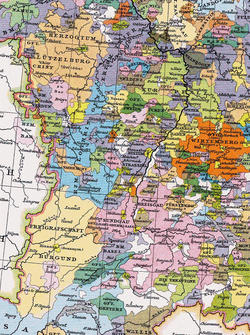Lorrain (province)
| Duchy of (Upper) Lorraine | ||||||||||
|
Duché de (Haute-)Lorraine (fr) Herzogtum (Ober-)Lothringen (de) |
||||||||||
| Vassal of East Francia and Holy Roman Empire | ||||||||||
|
||||||||||
|
||||||||||
|
Duchy of Lorraine (blue) within the Holy Roman Empire (c. 1400)
|
||||||||||
| Capital | Nancy | |||||||||
| Government | Feudal monarchy | |||||||||
| Duke | ||||||||||
| • | 959–978 | Frederick I of Bar | ||||||||
| • | 1737–1766 | Stanisław Leszczyński | ||||||||
| History | ||||||||||
| • | Lotharingia divided | 959 | ||||||||
| • | Joined Upper Rhenish Circle |
1500 | ||||||||
| • | Annexed by France | 1766 | ||||||||
|
||||||||||
| Today part of |
|
|||||||||
The Duchy of Lorraine (French: Lorraine, IPA: [lɔʁɛn]; German: Lothringen), originally Upper Lorraine, was a duchy now included in the larger present-day region of Lorraine in northeastern France. Its capital was Nancy.
It was founded in 959 following the division of Lotharingia into two separate duchies: Upper and Lower Lorraine, the westernmost parts of the Holy Roman Empire. The Lower duchy was quickly dismantled, while Upper Lorraine came to be known as simply the Duchy of Lorraine. The Duchy of Lorraine was coveted and briefly occupied by the Dukes of Burgundy and the Kings of France.
In 1737, the Duchy was given to Stanisław Leszczyński, the former king of Poland, who had lost his throne as a result of the War of the Polish Succession, with the understanding that it would fall to the French crown on his death. When Stanisław died on 23 February 1766, Lorraine was annexed by France and reorganized as a province.
Lorraine's predecessor, Lotharingia, was an independent Carolingian kingdom under the rule of King Lothair II (855–869). Its territory had originally been a part of Middle Francia, created in 843 by the Treaty of Verdun, when the Carolingian empire was divided between the three sons of Louis the Pious. Middle Francia was allotted to Emperor Lothair I, therefore called Lotharii Regnum. On his death in 855, it was further divided into three parts, of which his son Lothair II took the northern one. His realm then comprised a larger territory stretching from the County of Burgundy in the south to the North Sea. In French, this area became known as Lorraine, while in German, it was eventually known as Lothringen. In the Alemannic language once spoken in Lorraine, the -ingen suffix signified a property; thus, in a figurative sense, "Lotharingen" can be translated as "Land belonging to Lothair".
...
Wikipedia



